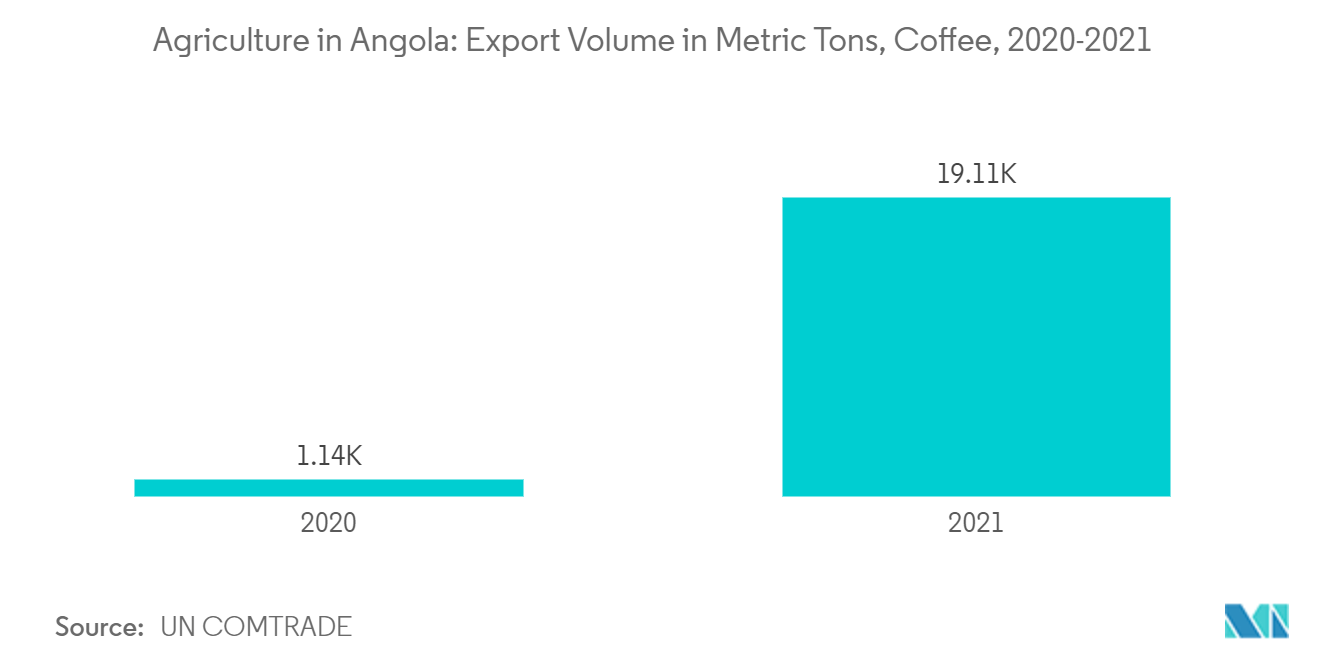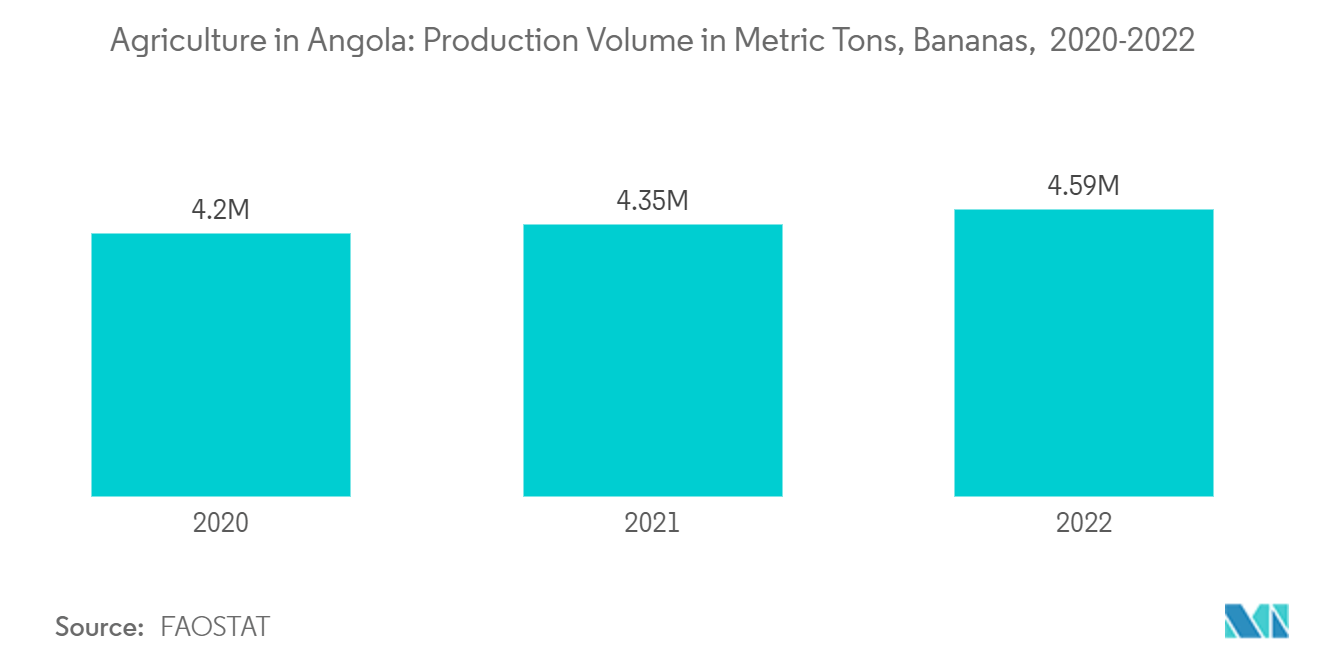Market Trends of Agriculture In Angola
High Regional Trade of Coffee Boosting the Angolan Market
In Angola, cereals, pulses, fruits, vegetables, and cash crops contribute to the country's agricultural production. Coffee is a significant crop in Angolan agriculture, with Angola being a leading coffee producer as well as exporter before the Civil War. To revive the competitiveness of Angolan coffee, the Angola Ministry of Agriculture implemented strategic policies. For instance, the government established the Angolan National Coffee Institute (INCA) to attract private investors for public-private partnerships (PPPs) and the development of a dedicated 'coffee fund' to support smallholder farmers. The focus on coffee is evident in the country's coffee exports, with 18,824 metric tons exported in 2023 compared to 1,312 metric tons in 2019, according to ITC Trade Map. In 2023, major export destinations for Angolan coffee included Portugal, Morocco, Spain, and Germany, with Portugal accounting for 37.8% of the total export value. Moreover, the country exported both raw and unprocessed coffee in the form of ‘cafe mabuba’ (dried cherries or parchment coffee) or ‘cafe commercial’ (green coffee).
According to FAOSTAT, the country harvested 16,767 metric tons of green coffee from 51,151 hectares of cultivable land in 2022, compared to 13,285.5 metric tons from 40,222 hectares in past years. Most of the coffee is produced in the Northern and Central regions, with the Uíge and Cuanza Sul provinces as the main producing regions. Angola produces two varieties of coffee, such as Coffea canephora, often known as Robusta26, and Coffea Arabica, also known as Arabica. Angolan Robusta coffee is well-liked for its distinct flavor and highest quality among producing countries. This is most likely owing to local farming practices, which often grow coffee in shadow, as well as environmental circumstances such as high altitude (e.g., some plantations are located around 1,100 meters above sea level) and soil type.
Besides, various international coffee growers have made significant investments to boost the country's coffee exports. For instance, Fazenda Vissolela, a prominent international coffee farm, planted 360 hectares of coffee in 2023 to expand to 1,000 hectares by 2027. Additionally, Fazenda Vissolela collaborates with 250 small-scale farmers to help local communities thrive. About 15% of the green coffee is sold under the brand Cafe Romana in the local market, while the rest is distributed to global partners like Nestle and Delta.
Therefore, the government's efforts, along with the involvement of foreign entities, will boost the country's coffee exports in the coming years.

Fruits and Vegetables are the Most Produced Commodities in the Angolan Market
Angola has experienced significant growth in its population, resulting in an increased demand for agricultural products, especially fruits and vegetables. To reduce reliance on imports and support local production, the government has been heavily investing in increasing its domestic production capacity. Moreover, Angola has ample resources such as land, water, soil quality, infrastructure, and climate to enhance its fruit and vegetable industries. In addition, Angola's seasons align with the Southern Hemisphere, with a colder period from June to September, unlike countries in the Northern Hemisphere like Costa Rica, Egypt, and Morocco, which give the country several climatic advantages.
Bananas, avocados, and citrus fruits are the major fruits produced in the country. Angola is the largest banana producer in Africa and the seventh largest worldwide, with an annual supply of over 4 million metric tons. According to FAOSTAT, in 2020, the country produced 4,204,538 metric tons of bananas, which rose to 4,589,099 metric tons in 2022. The Lobito Corridor, Huambo, and Benguela provinces are famous for their ideal climate for growing fruits. In Benguela, located at lower altitudes, tropical fruits like bananas, pineapples, and mangoes are grown well. Meanwhile, in Huambo, which has altitudes exceeding 1,200 meters, crops like avocados and citrus fruits flourish. Furthermore, in 2021, the Angolan government received funding from the African Development Bank for the development project of agricultural value chains in Cabinda province to make payments for small agro-processing equipment for banana production.
Likewise, the production of vegetables, such as tomatoes and onions, is on the rise in the country. According to FAO, the country produced 587,785 metric tons of tomato in 2022, recording a 4.62% increase over 2019. The popularity of dietary diversity and cultural cuisine in the country ensures a steady market for various vegetables, boosting the overall market.
Further, the conducive government policies are promoting the production of fruits and vegetables in Angola. The Ministry of Agriculture and Rural Development in Angola is collaborating with the private sector to achieve goals such as distributing seeds and tools and rebuilding rural infrastructure. The government has also supported the creation of large agricultural projects and businesses such as Gesterra SA, Aldeia Nova, and the Quiminha Project (PIDARQ). These initiatives are aimed at boosting private sector participation in agriculture, including the production of fruits and vegetables, to bolster the agricultural market in the country.


